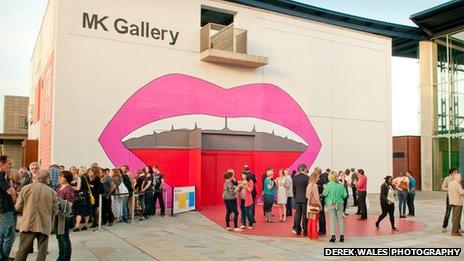Hariton Pushwagner exhibition in Milton Keynes
- Published

Pushwagner designed a pop art mouth for MK Gallery to reflect his satirical work about greed
An artist, hailed as the "modern-day Munch", is holding his first solo show outside Norway in Milton Keynes.
To welcome visitors, Hariton Pushwagner, 72, has designed an image of a cavernous mouth to transform the facade of the MK Gallery.
It seems that stepping on to a projecting tongue is an appropriate introduction to a show of his largely satirical work which targets greed and power.
Variously described as "eccentric" and "visionary", Pushwagner's detailed works contain elements of pop art and science fiction, and his existentialism has led to comparisons with Edvard Munch, the man behind The Scream.
Celebrity status
The Soft City exhibition in Milton Keynes brings together drawings, paintings and prints made by the Oslo-born artist over the last 40 years.
.jpg)
Hariton Pushwagner has been called the "modern-day Munch"
Despite being educated at the National Academy of Fine Art and the Cité Internationale des Arts Paris, his breakthrough came only in 2008 when the original drawings of his graphic novel Soft City were exhibited at the Berlin Biennale of Contemporary Art.
Since then he has quickly earned celebrity status in Norway, where people are fascinated by the rags-to-riches story of a man who lived on the streets for many years and lived a hedonistic lifestyle.
It was on the initiative of MK Gallery director Anthony Spira that Pushwagner was invited to show his work in Milton Keynes.
"I felt there was a particular aptness about his work being shown in a city established at roughly the same time as Pushwagner was creating these works," he said.
"And [Milton Keynes'] utopian ideal and grid square design has some visual affinity with many of his works."
'Defining work'
Soft City, which depicts disillusion with capitalism and life in the modern city, was created between 1969 and 1974 and all 154 pages are displayed in the exhibition.
Mr Spira said that this was probably Pushwagner's "defining work".
"It has often been classed as one of the top graphic novels ever made," he said.
"The characters in this novel live a completely mechanical existence, they are turned into robots basically."
13-almostthere(2).jpg)
Almost There from The Family of Man, a series of screen prints depicting the trappings of power
The exhibition, which can be seen until 2 September, also includes The Family of Man, a series of 34 silk screen prints that depict the trappings of power, and show a world under siege from pollution and mass destruction.
Meanwhile, in the Long Gallery, the Apocalypse Frieze comprises detailed paintings where factories double up as death camps and the ravages of war are perpetuated under the watchful eye of robotic men in suits.
All this will be exhibited alongside the Oblidor Guide Book, a sketchbook that reveals the artist's working process, plus other early work.
The exhibition will be complemented by a Norwegian season of video, music and performance events with around 50 Norwegian artists and curators.
Following its presentation in Milton Keynes, the exhibition will visit Haugar Vestfold Art Museum, Norway and Museum Boijmans Van Beuningen, the Netherlands.